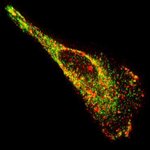Science category landing
Medicine

Wanted: stems cells. Just like those absconders chased by police all over the world, everybody can tell about their good deeds but none really knows how to recognize them. Yet, as of today, thanks to a study just published in the Proceedings of the National Accademy of Sciences (PNAS) and authored by Nobel Laureate for Medicine in 2007 Mario Capecchi and by the researcher from the Catholic University of Rome Eugenio Sangiorgi, we now know how to reveal the stem cells camouflaged in the pancreas.
A stem cell is a cell capable of generating all the other cells constituting the same tissue (…

LEXINGTON, Ky. (April 6, 2009) – The side effects of an experimental "gene-silencing" treatment that is currently being investigated for a variety of diseases are even more wide-ranging than previously discovered, according to a study by a University of Kentucky researcher.
Following up on groundbreaking research published last year in the journal Nature, Dr. Jayakrishna Ambati, a UK ophthalmologist , and his colleagues found that the new drug modality, siRNA (21-nucleotide small-interfering RNA), is toxic not only to blood endothelial cells, which line blood vessels, but also to the cells…

Biomedical engineers have developed a new type of probe that allows them to visualize single ribonucleic acid (RNA) molecules within live cells more easily than existing methods. The tool will help scientists learn more about how RNA operates within living cells.
Techniques scientists currently use to image these transporters of genetic information within cells have several drawbacks, including the need for synthetic RNA or a large number of fluorescent molecules. The fluorescent probes developed at the Georgia Institute of Technology circumvent these issues.
"The probes we designed shine…

Scientists have discovered that growing mouse skin cells in spheres can lead to generation of cells with properties of cancer stem cells, even without genetic manipulation of stem cell genes. This unexpected finding, published by Cell Press in the April 3rd issue of the journal Cell Stem Cell, provides a potential pathway for generation of cancer stem cells from differentiated cells and may even eventually lead to safer strategies for creation of induced pluripotent stem cells for use in regenerative therapies.
"A hallmark of all solid tumors is the outgrowth of cancer cells into three-…

A new study finds previously unidentified fibrocartilage-forming progenitor cells in degenerating, diseased human cartilage, but not in cartilage from healthy joints. The research, published by Cell Press in the April 3rd issue of the journal Cell Stem Cell, provides valuable insights into the reparative potential of cartilage and may lead to development of regenerative therapies for arthritis.
Osteoarthritis (OA) is an incurable degenerative disease caused by a progressive deterioration of the cartilage that cushions and protects joints. "OA is the most common musculoskeletal disease in the…

A new study has identified a potential strategy for removing the abnormal protein that causes Huntington's disease (HD) from brain cells, which could slow the progression of the devastating neurological disorder. In the April 3 issue of Cell, a team of researchers from the MassGeneral Institute for Neurodegenerative Disease (MGH-MIND) describes how an alteration to the mutated form of the huntingtin protein appears to accelerate its breakdown and removal through normal cellular processes.
"Using Huntington's disease as a model, we identified a mechanism whereby modification of the disease-…

A new study in the April 3rd issue of the journal Cell, a Cell Press publication, helps to explain why people who carry mutations in a gene known as Nurr1 develop a rare, inherited form of Parkinson's disease, the most prevalent movement disorder in people over the age of 65.
They have found evidence that the gene normally acts to suppress an inflammatory response and, in turn, the production of neurotoxins in the brain. Those neurotoxins can otherwise spawn the damage to dopaminergic neurons that is characteristic of Parkinson's disease. The findings not only offer new insight into the…

Special proteins known as prions, which are perhaps best known as the agents of mad cow and other neurodegenerative diseases, can also serve as an important source of beneficial variation in nature, confirms a new study in the April 3rd issue of the journal Cell, a Cell Press publication. After an extensive search through the genome of yeast for proteins with prion-like character, the researchers found two dozen prion-forming proteins, most of which had never been seen before.
"We had previously proposed prions as a means for generating phenotypic diversity," but that notion had been a…

Scientists have discovered a naturally occurring compound that triggers a plant's immune system, thereby protecting the plant from a secondary bacterial infection.
The patent-pending discovery could lead to an effective, inexpensive and environmentally safe way to improve plants' resistance to disease, according to research to be published in Science on April 3, 2009.
"The potential for crop protection for organic and conventional farming is strong," said Jean Greenberg, associate professor of molecular genetics and cell biology at the University of Chicago and corresponding author of the…

LA JOLLA, Calif., April 3, 2009 -- Investigators at Burnham Institute for Medical Research (Burnham) have demonstrated that attacks on the mitochondrial protein Drp1 by the free radical nitric oxide—which causes a chemical reaction called S-nitrosylation—mediates neurodegeneration associated with Alzheimer's disease. Prior to this study, the mechanism by which beta-amyloid protein caused synaptic damage to neurons in Alzheimer's disease was unknown. These findings suggest that preventing S-nitrosylation of Drp1 may reduce or even prevent neurodegeneration in Alzheimer's patients. The paper…